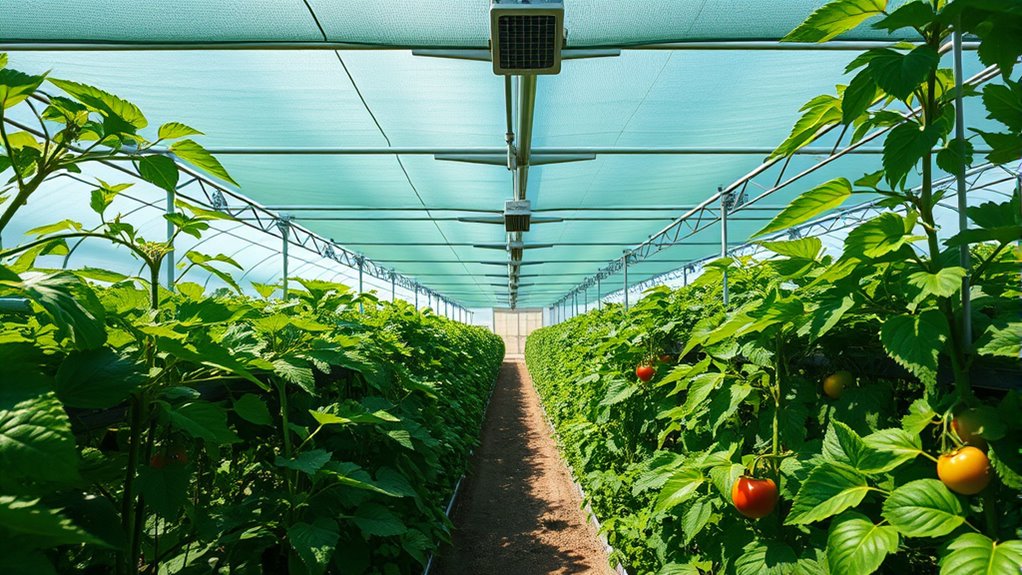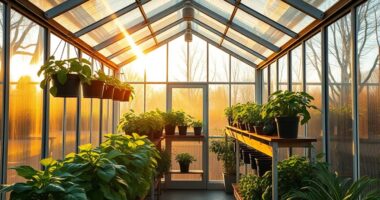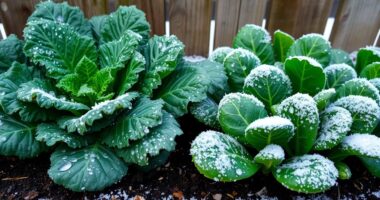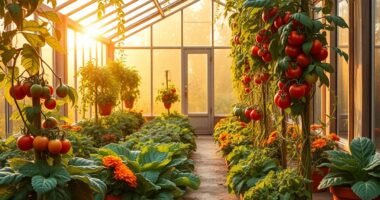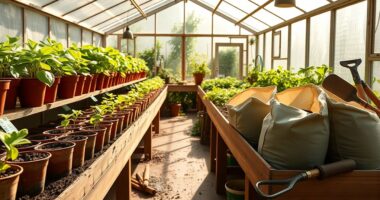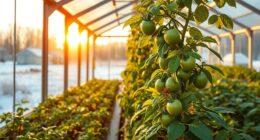To keep your summer greenhouse thriving, use shade cloths to reduce heat buildup while still allowing enough light for your plants. Pair this with cooling systems like exhaust fans, evaporative coolers, or misting to regulate temperatures further. Monitor humidity and adjust shading or cooling as needed during peak heat hours. Combining these strategies helps prevent heat stress and boosts yields, especially for high-value crops. Keep exploring these methods to optimize your greenhouse environment all season long.
Key Takeaways
- Use adjustable shade cloths to control sunlight and prevent heat buildup during peak summer hours.
- Combine shade with cooling systems like exhaust fans, evaporative coolers, and misters for optimal temperature regulation.
- Regularly monitor temperature and humidity to adjust shading and cooling strategies for ideal plant conditions.
- Position cooling devices strategically and ensure proper airflow to maximize their efficiency.
- Focus on high-yield crops such as tomatoes, peppers, and herbs by maintaining consistent, cool, and well-shaded environments.
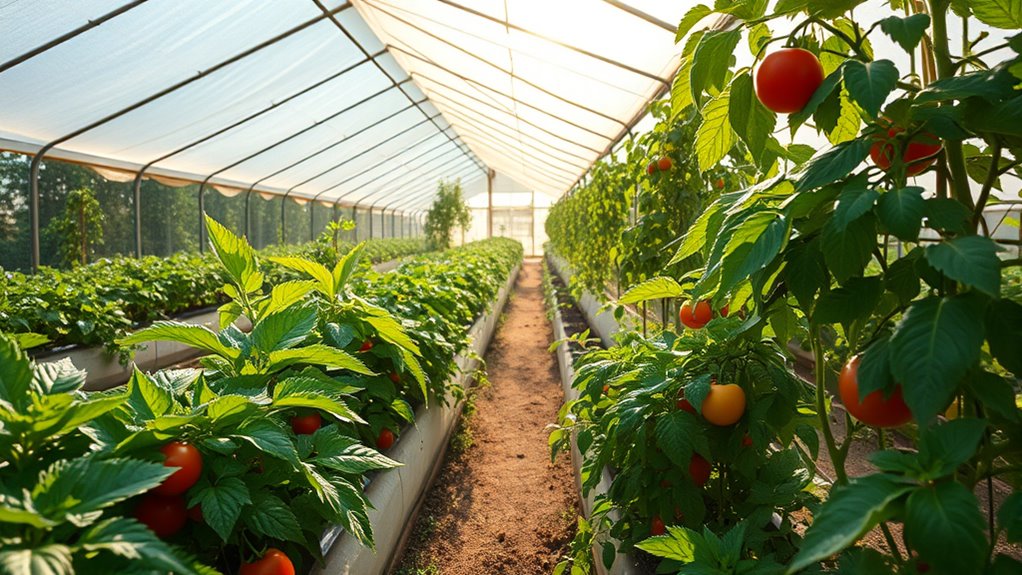
As summer heats up, maintaining a healthy greenhouse requires some extra attention. High temperatures can stress your plants, reduce yields, and even cause damage if you’re not prepared. To keep your greenhouse thriving during the hottest months, you need to focus on effective shading and cooling strategies. Shade cloths are one of your best tools for controlling heat buildup. They block out a significant portion of the sun’s intensity, reducing the temperature inside without depriving your plants of necessary light. Installing shade cloths over your greenhouse windows or sides is straightforward, and they come in various densities to tailor shade levels to your specific crops. For instance, leafy greens and herbs may need lighter shading, while fruiting plants might benefit from denser coverage. Alongside shade cloths, cooling systems play a critical role. Exhaust fans, evaporative coolers, and misting systems work together to lower the internal temperature and maintain ideal humidity. Exhaust fans help remove hot air, pulling cooler air in from outside, especially if you position them strategically near vents or openings. Evaporative coolers, which use water evaporation to cool incoming air, are energy-efficient options that work well in dry climates. Misting systems add moisture to the air and assist in temperature regulation while preventing plants from drying out. When setting up cooling systems, consider your greenhouse layout and the local climate. Proper placement and maintenance are essential for maximum efficiency. For example, misting nozzles should be evenly spaced and cleaned regularly to prevent clogging. Also, guarantee your cooling systems are compatible with your shade cloths, so they don’t interfere or cause unnecessary wear. Combining shading with cooling creates a more stable environment, helping plants tolerate heat stress and continue growing vigorously. Keep an eye on temperature and humidity levels with a reliable gauge, adjusting your shade cloths and cooling devices as needed. During peak heat hours, you might need to tighten shade cloths or run cooling systems longer to prevent overheating. Remember, good airflow is imperative. Open vents and doors during the hottest parts of the day to facilitate air exchange. Maintaining consistent environmental conditions ensures your high-value crops—like tomatoes, peppers, or herbs—reach their full potential, even during the summer months. To conclude, using shade cloths to block excess sunlight and deploying cooling systems to manage internal temperatures are key steps for summer success. These measures help prevent heat stress, promote healthy growth, and maximize your yields. With proactive adjustments and proper equipment, you can enjoy a productive, healthy greenhouse all season long, no matter how high the mercury climbs outside.
Frequently Asked Questions
What Are the Best Pest Control Methods for Summer Greenhouses?
You should focus on integrated pest management to keep pests under control. Start by regularly inspecting your plants for signs of trouble. Use biological control methods, like introducing beneficial insects such as ladybugs or predatory mites, to naturally reduce pest populations. Combine these approaches with physical barriers and proper sanitation. This proactive strategy helps you maintain a healthy greenhouse environment without relying heavily on chemical pesticides.
How Do I Manage Humidity Levels Effectively During Hot Months?
Managing humidity during hot months is like walking a tightrope—you need balance. Use a humidifier management system to maintain ideal moisture levels, preventing fungal issues. Select a dehumidifier suited to your greenhouse size for effective moisture control. Ventilate regularly to promote air circulation and reduce excess humidity. Monitoring with a hygrometer helps you stay on track. Proper humidity management keeps your plants healthy and thriving through the summer heat.
What Are Low-Maintenance Crops for Summer Greenhouses?
When choosing low-maintenance crops for your summer greenhouse, consider succulent varieties and herb gardens. Succulents thrive with minimal watering and are perfect for hot, dry conditions, while herbs like basil, mint, and thyme require little care and grow quickly. These plants can handle temperature fluctuations and need less attention, making them ideal for busy gardeners wanting reliable, high-yield options without constant fuss.
How Can I Extend the Growing Season in a Summer Greenhouse?
Imagine squeezing more from your greenhouse when the season’s nearing its end. To achieve season extension, you can use heaters on chilly nights and install thermal curtains for insulation. Practice crop rotation to keep soil healthy and prevent pests. Cover crops during off-seasons and consider supplemental lighting. These strategies work together to prolong your growing window, helping you harvest fresh produce even when the outdoor season winds down.
What Are the Cost-Effective Cooling Options for Large Greenhouses?
To cool a large greenhouse cost-effectively, you should focus on natural ventilation and shade cloths. Open vents and windows to promote airflow, reducing heat buildup without extra costs. Installing shade cloths can substantially lower interior temperatures by blocking excess sunlight. These methods are affordable, sustainable, and easy to implement, helping you maintain ideal conditions for your plants while saving on energy expenses.
Conclusion
As summer’s warmth gently whispers its arrival, remember these tips to keep your greenhouse thriving. With a little shade, thoughtful cooling, and mindful crop choices, you’ll nurture your plants through even the sunniest days. Embrace the quiet satisfaction of your efforts, knowing each careful step brings lush growth and bountiful harvests. In this delicate dance with summer’s intensity, your dedication gently fosters a haven of life and abundance—your greenhouse’s secret to enduring the season’s embrace.
